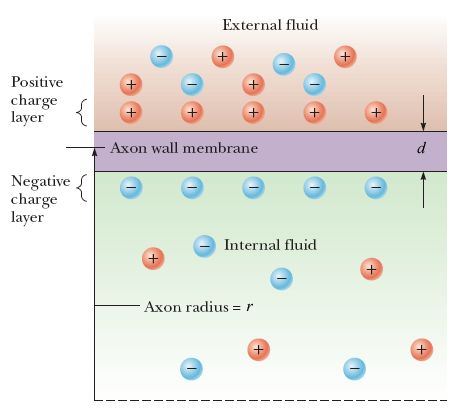Assume a length of axon membrane of about 0.10 m is excited by an action potential (length excited = nerve speed × pulse duration = 50.0 m/s × 0.0020 s = 0.10 m). In the resting state, the outer surface of the axon wall is charged positively with K+ ions and the inner wall has an equal and opposite charge of negative organic ions, as shown in the figure below. Model the axon as a parallel-plate capacitor and take C = ??0A/d and Q = CΔV to investigate the charge as follows. Use typical values for a cylindrical axon of cell wall thickness d = 1.6 ✕ 10−8 m, axon radius r = 1.9 ✕ 101 ?m, and cell-wall dielectric constant ? = 2.6. (a) Calculate the positive charge on the outside of a 0.10-m piece of axon when it is not conducting an electric pulse. (Assume an initial potential difference of 7.0 ✕ 10−2 V.) ?C How many K+ ions are on the outside of the axon assuming an initial potential difference of 7.0 ✕ 10−2 V? ?K+ ions (b) How much positive charge must flow through the cell membrane to reach the excited state of +3.0 ✕ 10−2 V from the resting state of −7.0 ✕ 10−2 V? ?C How many sodium ions (Na+) is this? ?Na+ ions (c) If it takes 2.0 ms for the Na+ ions to enter the axon, what is the average current in the axon wall in this process? ??A
Assume a length of axon membrane of about 0.10 m is excited by an action potential (length excited = nerve speed × pulse duration = 50.0 m/s × 0.0020 s = 0.10 m). In the resting state, the outer surface of the axon wall is charged positively with K+ ions and the inner wall has an equal and opposite charge of negative organic ions, as shown in the figure below. Model the axon as a parallel-plate capacitor and take C = ??0A/d and Q = CΔV to investigate the charge as follows. Use typical values for a cylindrical axon of cell wall thickness d = 1.6 ✕ 10−8 m, axon radius r = 1.9 ✕ 101 ?m, and cell-wall dielectric constant ? = 2.6.
(a) Calculate the positive charge on the outside of a 0.10-m piece of axon when it is not conducting an electric pulse. (Assume an initial potential difference of 7.0 ✕ 10−2 V.)
?C
How many K+ ions are on the outside of the axon assuming an initial potential difference of 7.0 ✕ 10−2 V?
?K+ ions
?C
How many sodium ions (Na+) is this?
?Na+ ions
(c) If it takes 2.0 ms for the Na+ ions to enter the axon, what is the average current in the axon wall in this process?
??A
(d) How much energy does it take to raise the potential of the inner axon wall to +3.0 ✕ 10−2 V, starting from the resting potential of −7.0 ✕ 10−2 V? (Assume that no energy is required to first raise the potential to 0 V from the resting potential of −7.0 ✕ 10−2 V.)
?J

Trending now
This is a popular solution!
Step by step
Solved in 3 steps
